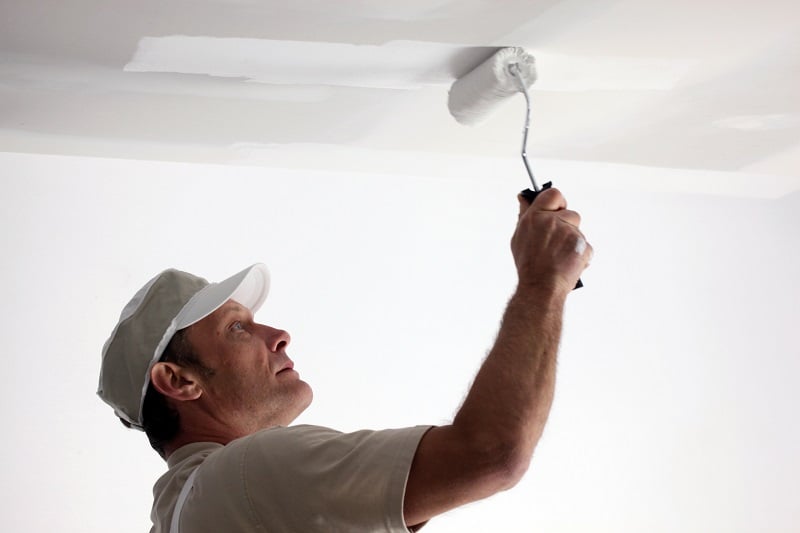
Painting a ceiling can be a long, arduous process—but it is often necessary and worth the visual impact. Follow this guide to painting flat ceilings for helpful tips concerning the right material choices, the best techniques, and the potential decision to hire a professional. This guide does not cover tips and processes involved in painting with drop or textured ceilings.
On This Page:
- Buying Paint
- Rollers vs Spray Painting & Other Project Tools
- Tips & Techniques
- Cleaning & Covering Stains
- Repairs
- Painting without Streaks or Roller Marks
- Working with Edges
- Preventing Splatter/Drips
- Large Ceilings
- Repainting
- How to Prime & Paint
- Drywall vs. Wood Ceilings
- FAQs
- Working with a Pro
Buying Ceiling Paint
The product you buy will ultimately come down to preference and budget. However, there are a few tips that might help you in your decision-making.
- Ceiling-specific Paint. Buy a variety designed specifically for this application. These are usually flat finish latex and come out with the most ideal results. They perform well in the two areas where this project could go wrong: splatter and drying. These application-specific varieties are slow-drying and less likely to splatter—though some drips are inevitable.
- No Gloss Finish. Don’t buy a product with a glossy finish. Semi-gloss and high-gloss finishes are highly reflective and detracting for room design. The best choice for most rooms will be a matte or flat finish in latex. However, there are certain situations that might call for a semi-gloss, such as in bathrooms and even kitchens.
- High Quality. You save yourself a lot of time and get better results when you choose higher quality products. A higher-quality product or one with a primer mixed in will require less coats overall. This work can be tough on your back and neck, and you will have limited use of a room during the days that the project is active. A shorter completion time can be a major advantage.
Popular Brands & Prices
| Brand | Price Per Gallon | Features |
|---|---|---|
| Behr | $30 – $50 |
|
| Valspar | $30 – $40 |
|
| Kilz | $30 – $50 |
|
| Glidden | $15 – $25 |
|
| Zinsser | $25 – $40 |
|
White vs. Colors
In most homes, these surfaces are white or some shade of white, and that trend continues in remodels and new construction. White makes for a brighter, lighter room and gives the illusion of a larger and taller space. It doesn’t distract the eye, allowing for intentional accents to draw attention.
The darker the ceiling is, the smaller and shorter a room will feel. Color will draw your eye away from other elements. If this is something you want in a space, darker shades are great at creating a sense of intimacy and comfort.
When choosing between white and—well, anything else—for your home, the most important thing to consider is the light that comes in and how prominent it is when you use that space most. Rooms that don’t get much natural light will benefit from having light, white color up above. Those that get excessive light may benefit from darker shades or warmer / cooler white tones. There are three popular options for using color:
- Slight variance – Ceiling slightly different shade than the walls. Room appears tall and open.
- Stark contrast – Ceiling is strong accent color with walls that are quieter color.
- Snug match – Ceiling matches walls. Cool, light grays or warm, rich beiges give room rich, “complete” design.
Best Paint for Kitchens, Bedrooms & Interior Areas
Though a flat or matte finish latex variety is the best for most of these applications, there are certain areas of the home where a different type might better serve the environment of the space. It is helpful to talk to an expert when deciding which type to use for your lifestyle and spaces in your home.
- Kitchen: Professionals recommend high-gloss and semi gloss varieties in acrylic or latex. They are easier to clean, more durable and are resistant to moisture. However, some people don’t like the reflective qualities of semi gloss and prefer a flat finish. Flat finish varieties with mildew and moisture blocking properties are available.
- Bathroom: Semi gloss options perform very well, blocking out moisture and mildew. Again, however, there are flat finish styles available.
- Bedrooms and Living Rooms: Water-based latex varieties in a matte or flat finish work best.
How Much Paint Do You Need?
A gallon will typically cover 350-400 square feet with one coat. If you are getting a high-quality product with a built-in primer, or if you prime beforehand, you should only need one coat. If the surface is darker, significantly stained, consists of fresh drywall or porous, you may need more coats.
To find out how many square feet you are working with, multiply the length of your ceiling by its width to get the square footage. To find out how much product you’ll need, divide that square footage by 350 or 400. Or, get the area dimensions and plug them into our paint calculator.
Ready to start your Ceiling Painting Project?
Find ProsReturn to Top
Roller Brushes vs. Spray Paint – Which is Easier and Best to Use?
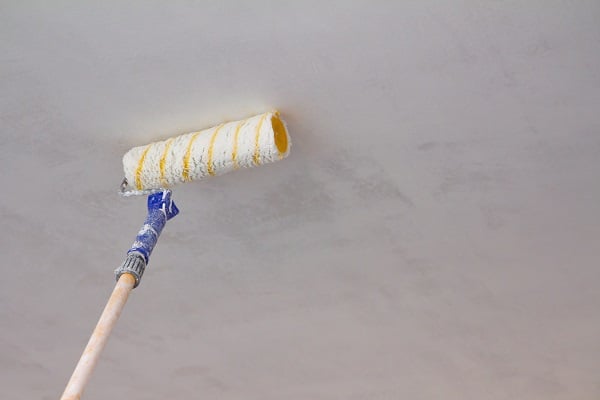
The ease and efficiency of either roller brushes or sprayers will depend on you and your project.
| Tools | Pros | Cons | Uses |
|---|---|---|---|
| Rollers |
|
|
|
| Spray |
|
|
|
Tools & Materials Needed
The tools and materials you choose could determine how seamlessly your project goes. Follow this tool checklist to find the best options for your needs and see the average prices below.
- Paint – $30-$60 per gallon
- Primer – $7-$20 per gallon
- Drop cloths – $10-$20 each
- Edge painter – $4-$15
- Ladder – $50-$150
- Painter’s tape – $3-$5
- Roller tray(s) – $5-$10 each
- Safety glasses – $2-$5 each
- Rags
- Extension pole – $5-$25+
- Roller – $2-$5 each
- Roller cover – $3-$15 each
- Extended roller kit (roller, cover, pole) – $10-$25
- Airless sprayer kit (pump, spray gun, hose) – $75-$250
Painting Tips & Techniques

Once you’ve started this project, you won’t want anything to slow you down or stop the process. You can avoid mistakes with proper preparation. Set yourself up for success before you get started. Research the best tips and follow the advice below.
How to Clean the Surface & Cover Stains
It’s important to clean and prep the surface so that the product can better adhere to it. If there is significant grit or grime, sand it lightly before cleaning. If the old surface is flaking, scrape or sand the flakes away. Then, use an extension pole to clean the surface with a sponge mop and a gentle cleaning agent—such as laundry or dishwashing detergent. Allow the surface to dry before proceeding.
If you clear away stains to the best of your ability, you will have a cleaner and smoother result. Stains can bleed through into new layers, especially if you opt not to use a primer. To deal with heavily stained, dirty surfaces, you can use Trisodium Phosphate (TSP) or another degreasting agent. This is a much stronger cleaning agent, so you must use it with care (gloves, safety goggles). Do not let TSP come into contact with your skin or eyes. Once it is dry, roll over it with primer. Also, consider buying a variety that applies a thicker layer than average.
Repairing Your Ceiling
For small repairs, use a putty knife and plaster over holes and damage. Allow it to dry, then gently sandpaper it so that it is smooth. For severely damaged drywall, it’s best to seek out a drywall repair pro. The process of repairing drywall involves removing the damaged portion and replacing it.
Best Way to Paint Without Leaving Streaks or Roller Marks
There are two well-known techniques for eliminating roller marks: perpendicular strokes and “W” strokes. Whichever style you prefer, roll in small sections and keep the edges of each area wet, so that it covers smoothly when you lead into the next section. For both methods, you should still “cut in.”
- Perpendicular – Roll parallel with the wall, then roll back over that area in the perpendicular direction (like a cross). For each new section, work from the middle and use long strokes.
- “W” – Also known as an “M” or “zig-zag” style, roll in a pattern of “W”s across the section, then go back over that area vertically. Start from a corner. Experts disagree whether this method is right for a DIY project because it risks leaving streaks if done incorrectly.
”Cutting In” or Painting Ceiling Edges
“Cutting in” is brushing a thin edge of 3-4 inches along the perimeter where a roller wouldn’t reach. You want to either keep the edges of this perimeter wet or feather them out, so that they blend right in when you roll. You can use either an angled brush or a special edge painting tool.
Preventing Splatter or Dripping onto Walls or Floors

Splatters are inevitable. The best way to protect the rest of the room is to cover it with drop cloths and tarps, and to use painter’s tape along the edges of your walls. For yourself, be sure to wear a hat, safety glasses and clothes you can ruin. You can reduce this inevitability by using high-quality products and lambswool roller covers. Lambswool covers are more expensive, but they grip and apply easily, minimizing splatter. They are also extremely durable and can last through several projects.
Working with a Large Ceiling
For larger surfaces, it may be more difficult to keep a “wet edge” along the sides of your sections. If this is a problem, use a feathered technique. At the edges, roll thinly out so that the next section can be blended into it.
Repainting
If you are repainting, you may have to make certain adjustments to your approach. For example, if you are using an identical color, you will likely only need one coat and you may not even need a primer. If you are applying a different color, you may need a special tinted primer to keep the previous color from bleeding through. The regularity with which you apply a new coat will depend on the use of the space, but the typical range is a broad 5-10 years.
Ready to start your Ceiling Painting Project?
Find ProsReturn to Top
How to Prime & Paint
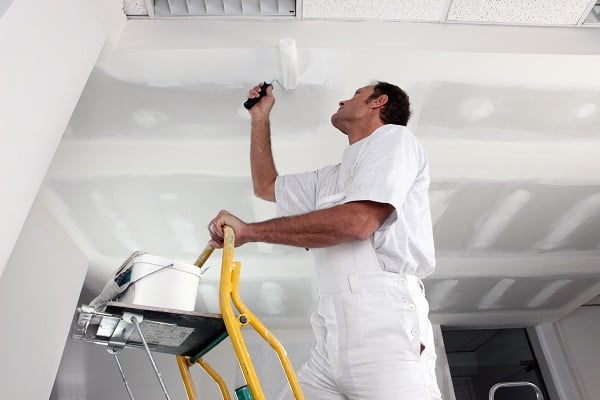
- Priming – If you are priming, applying that as your base layer will be your first step. You’ll want to apply it so that there is full coverage, though you don’t have to be as particular as you will be with the actual color. You will start by “cutting in” the edges, a technique that is detailed above. Then, you can use either the perpendicular or “W” technique according to your preference.
- Cutting In – Once that layer is fully dry, “cut in” the edges about 3-4 inches using the main color.
- Starting in the Corner – Choose a section to start in, typically a corner so that you can work off your perimeter. This section should be about 6 feet by 6 feet, so that it doesn’t dry too soon while you’re working on it. Use either the perpendicular or “W” method for each section.
- Rolling on the Paint – Marry the first section to the next as you go, and so on, until you have complete coverage. Do not stand directly under the roller as you work.
- Dry & Reapply – Allow to dry before determining if you need another coat.
Flat Drywall vs. Painting Wood Ceilings
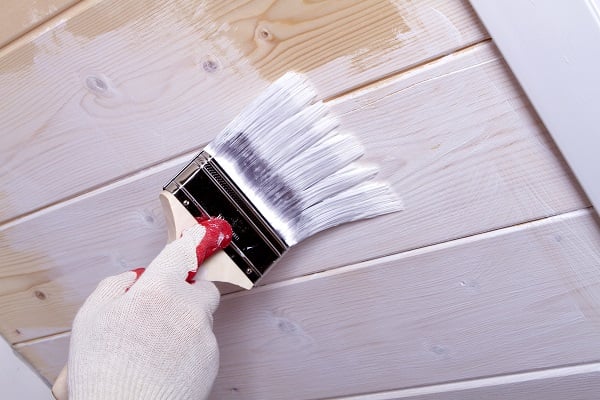
Wood will have different demands than drywall. It will need sanding and priming, where a drywall material may not call for that every time. A primer is necessary due to the porousness of the wood, and you may even need two coats of it. This project will take much longer to finish, and you will only be able to use an oil-based product on a stained wood. The stain will bleed through on water-based varieties.
FAQs
How Many Coats of Paint is Required?
If you use a primer or a primer-combined variety, you typically only need one coat. However, there are circumstances which call for more. If you are simply applying an identical color, you should only need one. If you are putting a dark color over a light one, the same is true. If you are doing a dark color over a light one, however, you may need more coats. In this case, you can save on materials by buying a tinted primer. If there are stains on the surface, use a primer and you will likely only need a single coat.
How Do You Remove Mistakes?
The best response to a mistake is a swift one. As soon as you notice a drip or splatter outside of the intended area, use water and a rag to wipe it away. If this doesn’t work, use a window cleaner or dishwashing detergent. If the spot is on a wall that you plan to work on anyway, you may be able to leave it until that time comes. Do not paint over it while it is still wet. If it is darker than the color you’re using, be sure to prime it first. If you need to smooth it out, you can sand it very lightly. For some flooring materials, like hardwood, you may be able to get dried drops up with a razor blade—just be gentle on your surfaces. You can clean some types of surfaces with paint remover.
How Should I Paint High Ceilings?
When dealing with high surfaces, you want to use extra precautions. The best precaution is to call a professional who will have safety training and the proper equipment. To do this yourself:
- Use a secure ladder or scaffolding.
- Use extended tools to clear dust, clean the surface, and to prime and paint.
- Let your cleaned surface dry completely before working, to ensure adhesion.
- Buy high-quality products designed for this application to minimize splattering.
- Coat from the top-down, for the smoothest job.
- To get to small, hard-to-reach spots, tape a small brush an extension pole.
How do you Paint Basement Ceilings?
The easiest way to coat exposed-beam basements will be to spray them. Rolling or brushing them by hand would take a lot longer. However, the process of familiarizing yourself with spray equipment and prepping the whole basement for the process—covering everything with drop cloths and tarps—is very time consuming. You should consider hiring a pro, especially if you anticipate running into ventilation problems. When working in the basement, you will find construction lights to be extremely useful. Primer will also be important, considering how porous wood is.
If you are finishing the basement and have fresh drywall, be sure to use primer or a primer-combined variety. Drywall is extremely absorbent.
What’s the Fastest Way to Paint a Ceiling?
Of course, the fastest way is to . They will know the best techniques, have top-performing tools and use high-quality products to get your job done quickly and without set-backs. To shorten the time on a DIY project, use quality products and tools so that every roll or brush of coverage counts. Lambswool roller covers, for example, will hold and distribute better and more efficiently than many other types of covers, and quality products are less likely to require a second coat.
Ready to start your Ceiling Painting Project?
Find ProsReturn to Top
DIY vs. Hiring a Painter
As a DIY project, this could cost as little as $70 and as much as $200. The cost to hire a professional painter could be $225-$550. This is a project that many homeowners feel comfortable doing themselves. However, you must take the time to prepare properly, cover everything up and follow the proper steps. If you don’t perform the job correctly the first time, you may end up calling in a pro anyway. An expert will be faster and more efficient, and their results will be more professional. They will know what materials are best for your job, will have the right tools and will follow safe procedures.
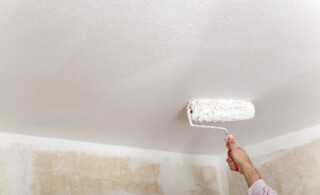 How to Paint Popcorn & Textured Ceilings
How to Paint Popcorn & Textured Ceilings  Painting or Wallpapering Your Interior Walls
Painting or Wallpapering Your Interior Walls  Can I Paint Over Wallpaper?
Can I Paint Over Wallpaper?  Wall Painting Techniques
Wall Painting Techniques  Painting vs. Hanging Wallpaper: What Are the Advantages of Each Option?
Painting vs. Hanging Wallpaper: What Are the Advantages of Each Option? 

High ceilings are difficult to paint and should always be done through pros